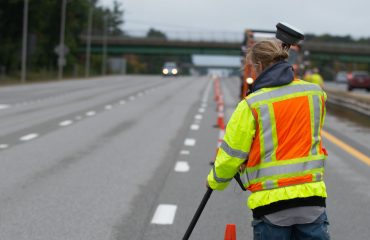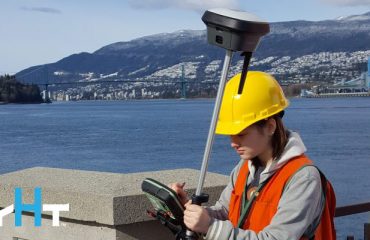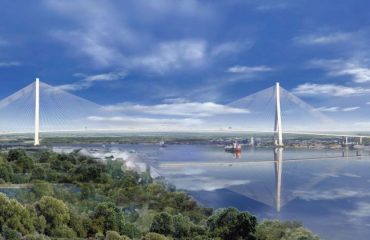Langan’s Russell Hall shares insights on his first six months using the Pegasus TRK mobile mapping system, how he’s innovating with data fusion, and why he relishes complex problems in this Tech Insider interview.
Russell Hall, PLS, isn’t sure how many miles he’s covered with mobile lidar, but it’s in the thousands. The Langan mobile mapping manager started out with the Leica Pegasus:One and then Pegasus:Two Ultimate before moving over to the Pegasus TRK 700 Neo in 2024. The difference in capabilities is startling, Russell says—especially now that they’ve had their TRK unlocked.
Russell believes there’s one sure way to create new opportunities: “Chance favors the prepared mind.” With more than 20 years of surveying experience, he’s developed a reputation for pushing the limits of surveying and mapping technology to explore what’s possible.
We recently sat down with Russell to learn about his first six months of TRKing, how he’s innovating with data fusion, and how he approaches complex problems. Russ shared some of his most intriguing projects and why he was completely shocked by the data they collected on a recent project in Connecticut. He also discussed some of the lessons he’s learned in his career and how he thinks AI will impact land surveying.
Watch the full interview, or browse the discussion highlights below.
What have you been doing that’s fun lately?
I’m having a lot of fun with Leica’s equipment. We were the first in the country to get our TRK scanner unlocked, so now we have four returns with the TRK and a bunch of other features that were also unlocked with this latest update, including LGSx. So there’s been a lot of testing and excitement with that.
I love experimenting and creating new workflows and operating procedures with every update for every piece of equipment with scanning and reality capture.
How many miles do you think you’ve mapped with mobile lidar over the course of your career?
If it’s just pure lane miles and not the double coverage, it’s got to be in the thousands.
Where are some of the most unexpected places you’ve used mobile mapping?
We had this one client that was in charge of doing guard rail replacement. They would go on Google Earth to see where it was failing and then they would have us scan and submit that for areas to be fixed. I thought that was an innovative way to do it.
The boat is still my favorite way to use it. It’s such a neat way to get underneath a bridge. A lot of times people just have terrestrial scanners, and you can’t reach or get the angles that you want. So it works very well to put the TRK on a boat.
We do a lot of work in the New York City area, and anytime you scan in Manhattan it presents a myriad of technical problems, whether it’s multipath or a complete outage for GPS or the logistics of driving. We’ve done all the tunnels in New York City and some really cool bridges, and they all present challenges that are unique to anywhere else in the country.
Are you seeing a lot of differences in technology between the Pegasus:Two mobile mapping system and the TRK?
Yes, we went from a phase-based scanner to time of flight, and we went from a single scan head with the original Pegasus to a dual head with the TRK. With the TRK Neo, even with the time of flight, the data is fantastic. It’s so clean. And we’re getting four returns like a drone lidar. So now we’re penetrating into vegetation even further. It’s very exciting.
One of the biggest changes was an overhaul in the way the registration was done from Pegasus into the TRK. It’s a very guided process through import, optimization, and finalization. Also the registration process has been revised now and it works very good. Now it has things like visual alignment, which for years I’ve been wishing existed in the Pegasus, so it’s fantastic to be able to force the clouds together. Now with the new update, we just got the ability to trim tracks and split tracks. So that really helps us deliver a unified LGSx for cloud-to-cloud registration and data fusion.
What is data fusion, and what is one of the most complex projects you’ve been involved with that uses data fusion?
Data fusion involves bringing together multiple sources of lidar in such a way that everyone understands the quality of the different data sets. A mobile scan is tighter than a drone lidar scan, for example, because of the registration process and systemic error.
We’ve gotten really good at doing project sites with our TRK. Then we look on the field tablet for holes. Let’s say there’s a big electrical cabinet or something blocking an area of a building. We go in with the RTC360 [terrestrial laser scanner] or BLK2GO [handheld imaging laser scanner] and infill behind it and then merge those data sets.
We did a section of highway where we flew the off-roadway portion with drone lidar. We TRKed the highway itself. And then we also put the TRK on a boat and captured data underneath a bridge. And then we fused all three data sources.
What are some key learnings that have helped you advance the work you’re doing at Langan?
For anything with reality capture, we can only ever be as good as the control. We can’t exceed the control. If your accuracy tolerances require digitally leveling through it, then that’s what you have to do. If you’re okay with RTK for control and it’s floating 600s, then you can’t expect any scan to exceed that. It’s impossible. It’s only going to be as good as that under the best-case scenario. So it’s really about understanding control and how accurate the project needs to be.
The biggest takeaway from mobile scanning is that you really want to start good and end good. What I mean by that is good sky, smooth IMU and drive lines, and then having good consistent control can pretty much get you out of almost any jam.
What has been the most impressive project that you’ve been able to accomplish with the TRK?
One project we’re doing for a state agency involves a very busy section of New Haven, CT. And we were completely shocked by the coverage that we’re getting with the amount of cars around. It’s absolutely fantastic; it just blows us away.
And then the other thing that surprised us was we put the TRK on UTV a few times and scanned some campuses, and the coverage and the details on the facades of the building are absolutely outstanding. Especially when you bring the TRK point cloud with its classification into Cyclone 3DR and get into meshing. Using all the different scripts combined with the TRK point cloud is really exciting.
What impact does this have on the work you’re doing for your clients?
It makes us more efficient. Getting more data means we don’t have to go back.
Then the TrueView viewer is the best viewer there is. So we can just send an LGSx file that has all the imagery and all the point clouds. Maybe you have landscape architects, and then they’re looking at the high-res photos. But maybe you have someone working on the lighting and they need to measure the light poles or other things that wouldn’t typically appear on a survey unless it was specifically asked. By having all that data, we don’t have to go back, and either they can measure it for themselves or we could just go in and extract it. This is a cost savings to the client, as well.
The LGSx format is compressed, so the files are smaller, even though they contain a monstrous amount of data. It’s feels lightweight; it’s very impressive.
So we’re able to provide better visibility into the data that we’re collecting and make it more easily accessible and digestible by different stakeholders in the project.
Are you seeing any advances in how people consume the data?
We’re starting to see the emergence of AI and more software programs able to ingest point clouds. This allows point cloud data to be presented to more people who are not in this industry. And that’s really going to make the industry explode. The more people that can consume the data, the more people are going to want it.
People want the viewers now. Requesting the point cloud data is becoming standard.
What are some of the things that Langan is doing to add more value to deliverables?
We have a lot of discussions with clients to understand what they do and how we can improve their workflow. A lot of times we’ve come up with custom solutions, whether it’s through scripts or custom deliverables with our in-house programmers. It’s a great feeling when you get to custom build a delivery for someone.
We use Cyclone 3DR and we have an innovation group at Langan including some brilliant programmers. We’ve taken some of the scripts that Leica provides and either improved on them or used them as an idea.
For example, we took a tree script that involved several steps and made it into one button press, where it’s making a surface and offsetting it and slicing. It works fantastic on TRK data sets.
How are you pushing the limits of technology to see what it’s capable of?
The manual is our starting point. From there we test the technology to see what happens if we do this or that? What happens if we drive at this speed? How much further does the point cloud go? How early do we need to stop the tracks to split them? All kinds of things.
We always test everything, push it to the limit. How hot can we use the system? How cold can we use the system?
My favorite mantra is “Chance favors the prepared mind.” I’ve found that to be true in my work and personal life. Someone will inevitably ask you, “Hey, can you use the scanner in 28 degrees?” And let’s say the manual says 32 degrees (just an arbitrary number for this example). Many people will use that as their limit. But because we’ve tested it and we know it can work down to 20 degrees, when an opportunity comes by, we are prepared to jump on it. That is the philosophy with all our testing.
How do you handle situations that don’t work out the way you expected?
You have to be prepared to admit that it’s not working and go back to the drawing board.
We will always deliver. It’s never an option to not deliver. Sometimes people say they can’t do a job. or they’ve been turned away by other providers because a job is too technically challenging. And that’s the kind of stuff that gets my ears perked up. But when you’re doing something no one’s done before or something that’s very technically challenging, it requires constant communication with the client and being upfront about everything. And people respect that and understand that. That’s how you build great relationships.
What do you enjoy the most about your work?
Most of our jobs are simple, straightforward projects. But the jobs where we get to figure things out or when I get to work on a new script or solve problems, I love that. That’s what makes me work well past when I even need to or anyone’s asking me. I just enjoy it. I enjoy playing with different software and being the first ones to figure out stuff.
What are you most excited about as you look to the future?
The rise and prevalence of AI in land surveying is going to be the next thing. I see no reason why Autodesk or Bentley couldn’t have AI; you hit a button and it knows how you set up your sheets or draft, and it just moves everything around.
And then also with point clouds. We’re seeing AI classification already in the TRK software, which is phenomenal, and we’re going to see it start to handle the extraction of features from a point cloud as well. I think we’re going to start to see that really coming into prevalence in the next year or two.
To talk to one of our experts and learn more about how to optimize your surveying potential, please contact us.



